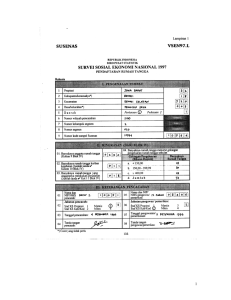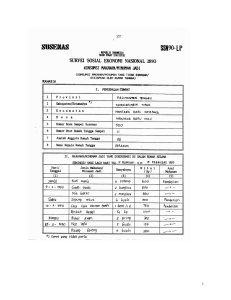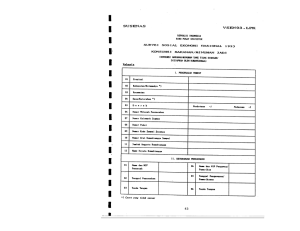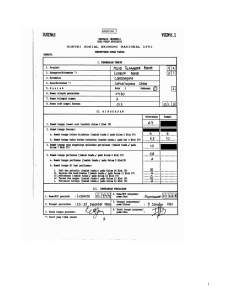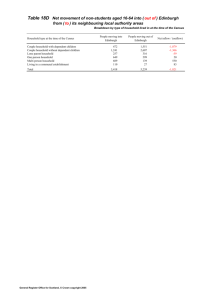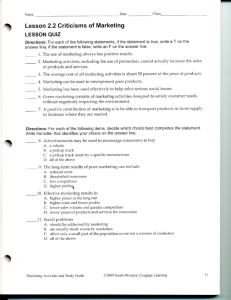NATIONAL SOCIO-ECONOMIC SURVEY 2001
advertisement
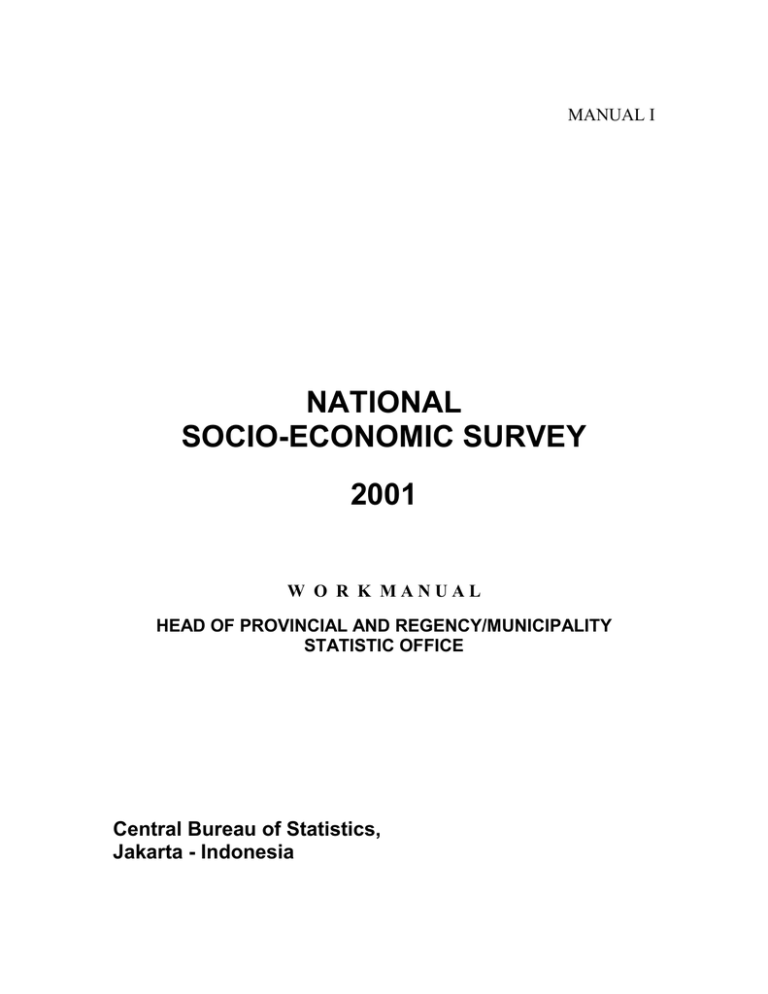
MANUAL I NATIONAL SOCIO-ECONOMIC SURVEY 2001 W O R K MANUAL HEAD OF PROVINCIAL AND REGENCY/MUNICIPALITY STATISTIC OFFICE Central Bureau of Statistics, Jakarta - Indonesia C O N T E N T S CONTENTS I. A. B. C. D. E. F. G. II. A. B. C. D. E. F. G. H. I. III. A. B. C. D. E. PREFACE General Objectives Scope Schedule of Activities Type of Collected Data Type of Lists and Documents Used Arranged statistic METHODOLOGY General Sample Outline Sample Design Census Block Map Sketch Number of Census Block Sample and Household Selected Census Block List Household Sample Selection Estimation Method Data Collecting Method FIELD ORGANIZATION Realization Guarantor Field Officers Training Field Officer’s Training Field Officer’s Working Days and Number of Training Days ATTACHMENTS Attachment 1: Census Block Map Sketch after Enuemration Attachment 2: Number Census Block Sample and SUSENAS 2001 Household Attachment 3: Number Census Block Sample and SUSENAS 2001 Household for Regency/ Municipality Estimation Level Attachment 4: Number of SUSENAS 2001 Officers, National Instructor, Class Attachment 5: Monthly Household Expenditure Group by Province Attachment 6: Random Digit Table Attachment 7: List of VSEN2001.DSBS Attachment 8: List of VSEN2001.L Attachment 9: List of VSEN2001.DSRT Attachment 10:List of VSEN2001.KM I. PREFACE A. General In order to implement their tasks, the Central Bureau of Statistics is responsible to provide data needed for planning sectional and cross sectional development. To observe the situation, monitor and evaluate the implementation of the development program, the availability of continuos data is very helpful in making improvements of an existing program if it is necessary. The social data produced by BPS were collected through Population Census (SP), Population Survey Between Census (SUPAS), National Labor Survey (SAKERNAS), and National Social Economic Survey (SUSENAS). Since 1992, some core data can give a description about population welfare which is collected every year thorough SUSENAS. Development progress could be evaluated gradually because of the availability of yearly data/ information SUSENAS is designed in order to collect social population data, which is relatively in the wide scope. Data collected are included education, health/ nutrition, housing/ environment, criminality, social culture action, income and consumption of household, travel, and household welfare. In 1992, Data collecting system was renewed. Information which is used to arrange population welfare indicator (in module; information is collected every three year) is joined in to core (information is collected every year). At that time being, SUSENAS provides tools that can be used to supervise population welfare level, formulate government program, and analyze population welfare improvement programs impact. In the new SUSENAS core consists some questions asking about condition and member of population attitude, which have tight relationship with welfare aspects. Here are some example question “Are you still attend school”, “Are you in health disruption”, “How do you take care your health”, “Who was the birth helper”, “How long the baby got the wet nursing”, and immunization to the children also bees asked. Beside all questions above, also been collected education info, household economic activity, and especially for the women have been asked about age when she got married, number of child, and Family Planning. Explanation from the module has taken turns to be collected in 3 years. At the first year, household income and expenditure were collected, at the second year household welfare socio culture, trips and criminality module were collected, and finally at the last year health, nutrition, education and housing were collected. Information in module is more detail and comprehensive question if it is compared to the same topic question in the core. Questions in core are collected in order to get important information to anticipate some changes that could be happened every year. They are also useful for short term planning, and the questions could be related with module’s questions such as expenditures. Questions in module are useful to analyze problems, which are unneeded to be supervised every year or to analyze government intervention, such as poverty and lack of nutrition. SUSENAS is potential to describe people welfare. Hopefully, SUSENAS data can cover some data availability gap to formulate policies and decisions in many fields. Some important things have to do in the future are formulating planning problems, supervising, or evaluating to find out solutions. Because of technology improvement, computerizing, make analysis working easier and indirectly SUSENAS data become more socialized. There are 32,348 households as sample size in 2001 SUSENAS, each household acts as core and module variable. With those sample size, 2001 SUSENAS can only produce national level estimation. Because of political and security reasons, Aceh and Maluku cannot be involved in 2001 SUSENAS. From some meeting with Department of health (health module), Department settlement and development area (housing module) and UNICEF, BPS realize to add 2001 SUSENAS sample to produce representative province estimation. This adding makes larger 2001 SUSENAS sample size, 61,696 (do not include Aceh and Maluku) and it is representative for province estimation. Together with UNICEF, BPS has successfully integrated Household Iodize Salt Survey in to SUSENAS since 1995 until 1997. To get comprehensive description about iodize salt, since 1998 Household Iodize Salt Survey is realized and funded by World Bank. Preliminary results of iodize salt survey are expected to be provided in June 2001. Because of that, all technical operations are expected to be finished at the end of February 2001, and can be delivered all before March 2001 (to BPS). B. Objective In general the objectives of collating data through Susenas is providing data of community welfare (Kesra) that reflects the social and economic condition of the community. Specifically 2001 SUSENAS goals are: (1) Provide raw data about people welfare, which is very important to make policies, and also act as the tool to supervise and evaluate the development. (2) Provide detail data about housing, health and nutrition, which is also important to formulate policies and act as the tool to control and evaluate the development. (3) Provide consumption household iodize salt data to investigate and evaluate the successfulness of iodize salt program. C. Scope The 2001 SUSENAS is conducted in all areas in Indonesia (not including Aceh and Maluku). The sample size is 61,696 households in the urban and rural area. Special households (live in special block census) like military complex and its kind and other special household like dormitory, jail, is not chosen as sample. The core data is collected using the VSEN2001.KM. D. Schedule of Activities --------------------------------------------------------------------------------------------------------------------------------Activity Date 1. 2. 3. 4. 5. 6. 7. 8. Document sending from BPS Training a. Main instructor b. National instructor c. Area Officials Implementation a. Household listing b. Household sampling c. Household enumeration List Checking a. Sub regency Statistic Office b. Provincial Statistic Office Send document to BPS a. VSEN2001.KM list (Stat. Bureau. Population Welfare) b. VSEN2001.GY list (Stat. Bureau. Population Welfare) c. VSEN2001.DSRT list (Stat. Methodological Bureau) Processing at BPS a. VSEN2001.KM list b. VSEN2001.GY list processing c. VSEN2001.DSRT list processing Evaluation and result discussion Publication Early October 2000 August 21-26, 2000 October 16-21, 2000 November 1-30, 2000 January, 2001 January 15-30, 2001 February, 2001 February–March, 2001 March-April 2001 March-April, 2001 February-March, 2001 March-April, 2001 March-June, 2001 March-May, 2001 April-May, 2001 July-October 2001 November-December, 2001 E. Type of Data Collected 2001 SUSENAS data collected including: 1. Characteristics on members of the household (name, relationship with head of the household, sex, age, marital status). 2. Characteristics of children (aged 0-14 years old), orphans and Children’s birth certificate ownership (aged 0-4 years old). 3. Characteristics of child labor and children time allocation (aged 5-14 years old). 4. Characteristics of children education (aged 3-6 years old) pre school, characteristics of education of household members aged 5 year old and above ; 5. Characteristics of economic activities of household members over the age of 10 years 6. Characteristics of health and nutrition, covering people health condition, nutrition status of women aged 15-49 years old, integrated post (posyandu) services, household expenditures on health, health insurance, and smoking habit. 7. Characteristics on fertility of ever-married women and information on Family Planning methods used by the married women. 8. Characteristics on the quality of household buildings, household facilities and environment. 9. Characteristics on the average household consumption and main source of household income 10. Characteristics of household rice stock. 2. Type of Household that is enumerated by Iodize Salt Questionnaire (VSEN2001.GY) 1. 2. F. People knowledge about iodize salt. Testing result of iodine composition in salt that is used in household. Type of Lists and Documents No A. Type of Lists/ Document Type of Lists Purpose 1. Census Block Map Sketch 2. 3. VSEN2001.L VSEN2001.DSRT 4. VSEN2001.KM 5. VSEN2001.GY To identify working area boundary Household listing Selected household sample listing Core-Module Module-Core household enumerating Enumerating of household salt consumption B. Type of Documents 1. Manual Book I 2. Manual Book II A 3. Manual Book II B 4. 5. Manual Book III Manual Book IV 6. Boundary Case Book Head of provincial, regency and municipality statistics office Enumerator Core-Module manual Supervisor Core-Module manual Age conversion manual Enumerating Household Iodize Salt Survey manual Boundary Case manual Done by Stored in Enumerator Supervisor Enumerator Provincial BPS BPS headquarter/ Provincial BPS BPS headquarter Enumerator BPS headquarter Provincial, regency and municipality BPS office Enumerator and supervisor Supervisor Enumerator and supervisor Enumerator and supervisor Main instructor and National instructor G. Arranged Statistics Kinds of statistics that are used to describe economic and social conditions can be found in 2001 SUSENAS core or module. Then, those data are used by development planner to evaluate the successfully of development. Statistics data which are arranged from 2001 SUSENAS activity can be differed in to 4 indicators, they are: 1. Population Welfare Objective Indicator for National and Province Level This indicator comes from core data collecting. It covers individual indicator; such as population, health, education, manpower, fertility, and Family Planning; and household indicator; such as housing and expenditures. 2. Health and Nutrition Indicator for National and Province Level This indicator comes from health and nutrition module data collecting. It covers some data such as health condition, movable treatment, in hospital treatment, health insurance, expenditures for health treatment, women aged 15-49 years old LILA (circle size of arm), and smoking habit. 3. Housing Indicators for National and Province Level This indicator comes from housing module data collecting. It covers settlement authorizing, physical condition of settlement, facilities and appliances of house and environmental condition. 4. Sufficiency of Iodize Salt Consumption Indicator for National and Province Level This indicator comes from household iodize salt data collecting. It covers some data such as iodized salt contents, household knowledge about iodized salt and accessibility to get iodized salt. Iodized salt consumption data are collected from VSEN2001.GY list. II. METHODOLOGY A. General 1999 and 2000 SUSENAS used enumerating area and segment group as unit sampling area to choose household enumerating area. In 2001 SUSENAS has provided new enumerating area; census block; which was formed when preparing 2000 Population Census enumeration. This census block will be used as sampling unit in 2001 SUSENAS realization. And of course 2001 SUSENAS enumerators need block census map sketch copy (SP2000-SWB, stored in Regency/ Municipality BPS offices) to know their working area. Not like previous SUSENAS, 2001 SUSENAS core data is not designed to estimate regency and municipality level, but 2001 SUSENAS is designed to estimate province level, both core and module data. This is as a result of budgetary cutting from central government (APBN = National Budget). However, technically, BPS still designs sample that can estimate regency/ municipality level. This action base on some provinces demand in order to get more detail estimation digit until regency/ municipality level. And this project will be financed by APBD (Provincial Budget). B. Outline Sample The 2001 SUSENAS outline sample is divided in three; outline sample in sub-regency selection (special for rural area), outline sample in census block selection and outline census in household selection. Outline sample in sub-regency selection (special for rural area) is sub-regency listing in every regency/municipality, which is sorted geographically. Outline sample in census block selection (urban area) is census block listing which is differed by census block in big city, medium city and small city in every regency/ municipality. For rural area, census blocks selection uses census block listing in selected sub-regency. Outline census in household selection is household listing in VSEN2001.L Block IV. C. Sample Design Like mention before, BPS will prepare 2001 SUSENAS sample for regency/ municipality level estimation if provincial government allocates their budget (APBD). Because of that, sample designs for regency/ municipality level estimation are integrated with 2001 SUSENAS sample design which are financed by National Budget (APBN). 2001 SUSENAS sample design is double outline samples for urban area and triple outline samples for rural area. Sample selection for both urban and rural area is done separately. For urban area, first step, selecting some of census blocks by systemic linear sampling from census block outline sample. Then, from each selected census block is selected 16 households by systemic linear sampling. For rural area, first step, selecting some sub regencies by probability proportional to size from sub regency outline sample (size = number of households in sub regency). The second step, selecting some of census blocks by systemic linear sampling from each sub regency. And the last, selecting 16 households by systemic linear sampling from each selected census block. To present data estimation in province level that is financed by National Budget, sub regency sample (for rural area)/ census block (for urban area) are sub sample from sub regency sample/ census block which are used to estimate regency/ municipality level. They all are selected from selected census block/ sub regency list, which is used to estimate regency/ municipality level in systemic sampling method To fasten the presentation of 2001 SUSENAS estimation results at national level, some census blocks are selected from census block samples (financed by National Budget). Sample selection selects by systemic sampling. Notes” 1. Number of sample of 2001 Household Iodized Salt Survey is equal with previous year sample (2000)., Census block sample/ household sample is sub sample of special regency/ municipality, which is divided in some regencies/ municipalities. 2. D. For selected census block that has no household listing (not financed by National Budget), selecting selected household for 2001 Iodized Salt Household Survey from 2000 Population Census household listing (the code SP200-L1). Census Block Map Sketch Every 20001 SUSENAS supervisor has to make the copy of census block map sketch (SP2000-SWB), on the sheet of paper. The original SP2000-SWB is made by 2000 Population Census officers. Enumerator to identify his census block boundary area uses this copy. In the list of VSEN2001.L, enumerator has to enumerate every physical building, physical census and household. E. Number of Census Sample Block and Household Number of census sample block and household in 2001 SUSENAS in every province that is financed by central government (APBN = National Budget) is attached in “Attachment 2” and number of census sample block and household in 2001 SUSENAS in every province that is financed by provincial government (APBD = Provincial Budget) is attached in “Attachment 3”. F. List of Selected Census Block In the list of 2001 SUSENAS Census Block (look at “attachment 7”), every selected census block is coded by NKS (Sample Code Number). NKS consists of 3 digits. The 3 digits are the serial number of selected census block in each regency, and they are arranged in these ways: a. Number 001 to 499 are selected census block serial number for rural area. b. Number 500 and over are selected census block serial number for urban area. To know whether a 2001 SUSENAS selected census block is financed by APBN or by APBD or urgently processed, can be differentiated by its “check mark” in column 6, column 7 and column 8 in VSEN.DSBS. Check mark in column 6 means urgently processed, check mark in column 7 means provincial estimation level, and check mark in column 8 means regency/ municipality estimation level. G. Selection of Household Sample Number of household that has to be selected is 16 households. Supervisor selects household sample selection by systemic sampling method after he/ she received registration result of household in each census block (VSEN2001.L) from enumerator. Supervisor has to count the sample interval and the first random digit in each census block. List of household in column 8 up to column 10, Block IV, List of VSEN2001.L is used to select household. Enumerator has to use “Attachment 5” to fill group of household expenditure monthly in Column 8 to 10. Household Sample Selection Procedures The procedures on selecting samples of household are like these: (supervisor) a. b. c. Check whether the “check mark” has in the right position in column 8 to 10 (done by enumerator) Give serial number on Column 8’ s “check mark”, starting from 1 to the last number. If it is completed, continue to Column 9’s and 10’s “check mark”. Please check whether the last serial number in Column 10’s “check mark” shows number of household in selected census block (the “filler” has to be the same as the “filler” in the last serial number in Column 5). If it is not the same, there should be a mistake in Column 5 or in Column 8 to 10. Correct the mistake first before doing sample selection. d. e. f. g. H. Count the Sample Interval (I) for household selection: I = Number of household from household listing result 16 Sample interval is counted up to two digits behind coma. Using Random Digit Table (see “Attachment 6”), decide the random start digit (R.1) which is the value is smaller than or equal to interval (I). Circled the serial number on the same “check mark” with random start digit (R.1), then used sample interval to count the next random digits, R.2, R.3, …., R.16 like these below: R.2 = R.1 + I; R.3 = R.1 +2 I; . . R.16 = R.1 + 15 I Circled the serial number in the Column 8’s to 10’s “check mark” which are same with selected random digit. If Serial number in Column 8 to 10 have been circled, then physical building serial number, census building and household serial number have to be circled too. The 16 households are listed in VSEN2001.DSRT and made double. One for enumerator and it is stored in Provincial BPS office and other for BPS (Statistics Methodology Bureau). Estimation Method Below is the prediction formula for 2001 SUSENAS realization result in regency/ municipality in rural and urban area: Urban Area yku = bu 16 1 ∑ ∑ yij 16 bu i=1 j=1 ^ Ŷku = Pku yku yku = Predicted mean value of y at regency/ municipality k area u. Ŷku = Predicted total value of y at regency/ municipality k area u. yij = Characteristic bu = value of household’s –j, selected census block -i. Number of selected census block at regency/ municipality k area u. ^ Pku = Predicted number of household y at regency/ municipality k area u. Rural Area yku = n br 16 1 ∑ ∑ ∑ 16 br j=1 i=1 t=1 yij ^ Ŷkr = Pkr ykr ykr = Predicted mean value of y at regency/ municipality k area r. Ŷkr = Predicted total value of y at regency/ municipality k area r. ytij = Characteristic br = value at sub regency –j, selected census block –i, household’s -t. Number of selected census block at regency/ municipality k area r. ^ Pkr = Predicted number of household y at regency/ municipality k area r. Predicted mean value of y at regency/ municipality k area u and r : y k (u+r) = Ŷku + Ŷkr ^ ^ Pku + Pkr Predicted total value of y at regency/ municipality k urban area (Ŷku) + rural area (Ŷkr) Ŷk (u+r) = Ŷku + Ŷkr Predicted total value of y at province level urban area (Ŷku) or rural area (Ŷkr) of regency/ municipality, counted by formula below: T Ŷpu = ∑ Ŷku and Ŷpr k=1 T = ∑ Ŷkr k=1 T = Number of regency/ municipality at province p Predicted total value of y at province level urban area (Ŷpu) + rural area (Ŷpr) Ŷp(u+r) = Ŷpu + Ŷpr Predicted mean value of y at province level area u and r : y p(u+r) = Ŷpu + Ŷpr ^ ^ Ppu + Ppr Predicted total value of y at national level urban area , counted by formula below: L Ŷn(u+r) = ∑ (Ŷpu + Ŷpr) p=1 L = Number of province in Indonesia Predicted mean value of y at national level, counted by formula below : y n(u+r) = Ŷn(u + r) ^ Pn(u + r) Ŷn(u + r) = Predicted household number in Indonesia live in urban area and rural area. I. Data Collecting Method Selected household’s data are collected using direct interviewing between enumerator and respondent. For individual questions (in 2001 SUSENAS questionnaire), it is necessary to ask the person who is connected with the questions. Household characteristics can be collected by asking the head of household, the husband/ wives, or other household member who is knowing much about characteristics asked. III. FIELD ORGANIZATION A. 1. Realization Guarantor BPS Head of BPS is responsible to all 2001 SUSENAS activities. He also gives instruction, technical directing and administration directing about SUSENAS realization. In realizing his authority and responsibility, head of BPS has a right to form an advisor team. Technical guarantor for 2001 SUSENAS data collecting is Head of Statistic Bureau of Population Welfare. 2. BPS at Province Level 1. 2. 3. 4. 5. 6. 3. BPS at Regency/ Municipality 1. 2. 3. 4. B. Be responsible in realizing 2001 SUSENAS at province integrally. Technical guarantor for 2001 SUSENAS is Head of Statistic Bureau of Population Welfare. Coordinating 2001 SUSENAS enumeration in all areas, based on the direction. Distributing all documents to regency/ municipality BPS. Giving direction to Head of regency/ municipality BPS about number of officers needed based on the direction. Coordinating recruitment method and presenting officers training. Supervising 2001 SUSENAS realization and evaluating 2001 SUSENAS results. Be responsible in realizing 2001 SUSENAS at regency/ municipality integrally. Technical guarantor for 2001 SUSENAS is Head of Statistic Section of Population Welfare. Realizing the direction from Head of Provincial BPS, such as officers mobilization, filed officers, etc. Distributing all documents to SUSENAS enumerators. Supervising 2001 SUSENAS enumeration and evaluating the answers of List 2001 SUSENAS. Fields Officers 1. 2001 SUSENAS Enumerators (PCS) a. b. c. d. 2. Participating in 2001 SUSENAS field officer training. Enumerating based on working area direction and the schedule. Rechecking the enumerating results (documentation completeness, completeness, quality of data collected). Submitting 2001 SUSENAS document that has been filled to the supervisor. answering 2001 SUSENAS Supervisors (PMS) a. b. c. d. e. f. Participating in 2001 SUSENAS field officer training. Supervising based on working area direction and the schedule. Rechecking the enumerating results from enumerators (documentation completeness, answering completeness, quality of data collected). Giving the best direction and solution of any problem that been asked by enumerators. Organizing all of his/ her enumerators. Collecting and arranging all documents as enumeration results to be submitted to Regency/ Municipality BPS. C. Training The procedures of forming the skilled field officers are using three steps training systems. First, the informant trains Core Instructors (Intama). Second, Core instructor (Intama) that has been trained trains National Instructors (Innas) and the last step, the trained National instructor (Innas) will train filed officers (enumerators and supervisors). The first training is training for Intama’s class, which is organized for 4 effective days. The training has some subjects, some of them are methodology, field organization, and 2001 SUSENAS concept and definition. This training using discussion (dialogical) method. The next training is for Innas. The objective is to make Innas more skilled in giving instruction to field officers. Finally, the trained Innas will teach officers how to collect data, fill the questionnaire and inform about the concept and definition. Criteria to be a National Instructor (Innas) 1. 2. Working in the field that has relationship with social and population affairs. Minimum a bachelor. Before October 2000, Innas candidates should have been registered. Innas candidates are differs in two, central Innas and local Innas. D. Field Officers Training 2001 SUSENAS enumerators and supervisors are recruited from BPS staffs in regency/ municipality, sub regency staffs, or statistical hired workers who have SUSENAS experience. Criteria to be a Numerator or Supervisor 1. 2. E. Minimum graduate from High School (the same level). Prioritized to whom has good performance in other BPS survey or training. Working Load and Training Days for Field Officers a. b. c. A numerator has two selected census blocks working load. A supervisors supervises and evaluates 4 enumeration results from 4 enumerators. Enumerator has 3 effective days for field officer’s training and supervisor has 4 effective days. Attachments Attachment 1 Census Block Map Sketch after Enumeration Attachment 2 NUMBER OF CENSUS BLOCK SAMPLE AND 2001 SUSENAS HOUSEHOLD Province Census Block Household (1) Daerah Istimewa Aceh (2) - (3) - Sumatra Utara 184 2944 Sumatra Barat 112 1792 Riau 104 1664 Jambi 72 1152 Sumatra Selatan 128 2048 Bengkulu 64 1024 Lampung 136 2176 DKI Jakarta 192 3072 Jawa Barat 512 8192 Jawa Tengah 472 7552 Daerah Istimewa Yogyakarta 144 2304 Jawa Timur 552 8832 Bali 120 1920 Nusa Tenggara Barat 136 2176 Nusa Tenggara Timur 112 1792 Kalimantan Barat 120 1920 Kalimantan Tengah 72 1152 Kalimantan Selatan 112 1792 Kalimantan Timur 72 1152 Sulawesi Utara 88 1408 Sulawesi Tengah 72 1152 Sulawesi Selatan 144 2304 Sulawesi Tenggara 72 1152 - - 64 1024 3856 61696 Maluku Irian Jaya Total Attachment 3 NUMBER OF CENSUS BLOCK SAMPLE AND 2001 SUSENAS HOUSEHOLD For Regency/ Municipality Estimation Province Census Block Household (1) Daerah Istimewa Aceh (2) - (3) - Sumatra Utara 820 13120 Sumatra Barat 540 8640 Riau 592 9472 Jambi 380 6080 Sumatra Selatan 428 6848 Bengkulu 152 2432 Lampung 404 6464 DKI Jakarta 380 6080 Jawa Barat 1438 23008 Jawa Tengah 1578 25248 Daerah Istimewa Yogyakarta 216 3456 Jawa Timur 1814 29024 Bali 358 5728 Nusa Tenggara Barat 282 4512 Nusa Tenggara Timur 532 8512 Kalimantan Barat 342 5472 Kalimantan Tengah 230 3680 Kalimantan Selatan 418 6688 Kalimantan Timur 422 6752 Sulawesi Utara 324 5184 Sulawesi Tengah 312 4992 Sulawesi Selatan 958 15328 Sulawesi Tenggara 232 3712 - - 422 6752 13574 217184 Maluku Irian Jaya Total Attachment 4 NUMBER OF OFFICERS, INNAS AND CLASS 2001 SUSENAS Province Officers Innas Class PCS (2) - PMS (3) - Total (4) - PCS (5) - PMS (6) - Total (7) - I (8) - II (9) - Total (10) - Sumatra Utara 92 23 115 1 2 3 3 2 5 Sumatra Barat 56 14 70 1 1 2 2 1 3 Riau 52 13 65 1 1 2 2 1 3 Jambi 36 9 45 - 1 1 1 1 2 Sumatra Selatan 64 16 80 1 1 2 2 1 3 Bengkulu 32 8 40 - 1 1 1 1 2 Lampung 68 17 85 1 1 2 2 1 3 DKI Jakarta 96 24 120 1 2 3 3 2 5 Jawa Barat 256 64 320 2 5 7 7 6 13 Jawa Tengah 236 59 295 2 4 6 6 6 12 Daerah Istimewa Yogyakarta 72 18 90 1 1 2 2 2 4 Jawa Timur 276 69 345 2 5 7 7 7 1 Bali 60 15 75 1 1 2 2 1 3 Nusa Tenggara Barat 68 17 85 1 1 2 2 1 3 Nusa Tenggara Timur 56 14 70 1 1 2 2 1 3 Kalimantan Barat 60 15 75 1 1 2 2 1 3 Kalimantan Tengah 36 9 45 - 1 1 1 1 2 Kalimantan Selatan 56 14 70 1 1 2 2 1 3 Kalimantan Timur 36 9 45 - 1 1 1 1 2 Sulawesi Utara 44 11 55 - 1 1 1 1 2 Sulawesi Tengah 36 9 45 - 1 1 1 1 2 Sulawesi Selatan 72 18 90 1 1 2 2 2 4 Sulawesi Tenggara 36 9 45 - 1 1 1 1 2 - - - - - - - - - 32 8 40 - 1 1 1 1 2 1928 482 2410 19 37 56 56 44 100 (1) Daerah Istimewa Aceh Maluku Irian Jaya Total Attachment 5 NUMBER OF OFFICERS, INNAS AND CLASS 2001 SUSENAS Province (1) Daerah Istimewa Aceh Column 8 (2) - Urban Column 9 (3) - Column 10 (4) - Column 8 (5) - Rural Column 9 (6) - Column 10 (7) - Sumatra Utara <525 525.00-949.99 ≥950 <400 400.00-699.99 ≥700 Sumatra Barat <550 550.00-999.99 ≥1000 <425 425.00-799.99 ≥800 Riau <625 625.00-1099.99 ≥1100 <450 450.00-749.99 ≥750 Jambi <525 525.00-949.99 ≥950 <350 350.00-649.99 ≥650 Sumatra Selatan <500 500.00-924.99 ≥925 <350 350.00-649.99 ≥650 Bengkulu <525 525.00-999.99 ≥1000 <375 375.00-649.99 ≥650 Lampung <550 550.00-999.99 ≥1000 <325 325.00-649.99 ≥650 DKI Jakarta <725 725.00-1249.99 ≥1250 - - - Jawa Barat <500 500.00-924.99 ≥925 <350 350.00-649.99 ≥650 Jawa Tengah <400 400.00-774.99 ≥775 <300 300.00-524.99 ≥525 Daerah Istimewa <425 425.00-899.99 ≥900 <325 325.00-624.99 ≥625 Yogyakarta <425 425.00-824.99 ≥825 <300 300.00-549.99 ≥550 Jawa Timur <550 550.00-999.99 ≥1000 <450 450.00-774.99 ≥775 Bali <425 425.00-824.99 ≥825 <325 325.00-599.99 ≥600 Nusa Tenggara Barat <500 500.00-924.99 ≥925 <275 275.00-549.99 ≥550 Nusa Tenggara Timur <575 575.00-1074.99 ≥1075 <400 400.00-674.99 ≥675 Kalimantan Barat <550 550.00-1024.99 ≥1025 <400 400.00-699-99 ≥700 Kalimantan Tengah <500 500.00-974.99 ≥975 <350 350.00-624.99 ≥625 Kalimantan Selatan <525 525.00-999.99 ≥1000 <425 425.00-799.99 ≥800 Kalimantan Timur <475 475.00-849.99 ≥850 <350 350.00-649.99 ≥650 Sulawesi Utara <500 500.00-949.99 ≥950 <350 350.00-649.99 ≥650 Sulawesi Tengah <500 500.00-924.99 ≥925 <350 350.00-674.99 ≥675 <450 450.00-849.99 ≥850 <325 325.00-649.99 ≥650 - - - - - - <550 550.00-1049.99 ≥1050 <225 225.00-499.99 ≥500 Sulawesi Selatan Sulawesi Tenggara Maluku Irian Jaya
